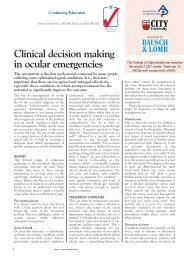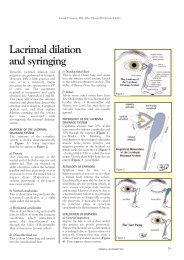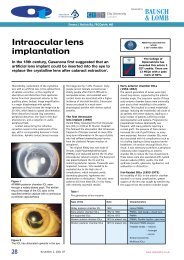April 2011: C-15873 Paediatric Optometry Part 1
April 2011: C-15873 Paediatric Optometry Part 1
April 2011: C-15873 Paediatric Optometry Part 1
Create successful ePaper yourself
Turn your PDF publications into a flip-book with our unique Google optimized e-Paper software.
The correct answer is D. Spherical lenses (not toric) are appropriate for the prescription shown and<br />
children adapt well to daily disposable lenses which have the advantage of not needing daily<br />
cleaning. 4 Rigid gas permeable lenses are an option, but some children are discouraged by<br />
discomfort during the early stages of adaptation. Continuous wear with silicone hydrogel lenses is<br />
another option, but this modality is fitted less often to children because of the higher risk of<br />
microbial keratitis.<br />
3. When fitting contact lenses for the patient in Image A, which of the following statements is<br />
TRUE?<br />
a. They will accommodate more with spectacles compared to contact lenses<br />
b. They will accommodate less with spectacles compared to contact lenses<br />
c. A correction for back vertex distance is required for the left eye but not the right eye<br />
d. Over-refraction will not be necessary after correction for back vertex distance<br />
The correct answer is A. The ocular accommodation that is required through contact lenses is<br />
different from that through spectacles. Spectacles induce less accommodation in myopes and more<br />
accommodation in hyperopes than that exerted by an emmetrope, or the ametrope when wearing<br />
contact lenses. A correction for back vertex distance is most important in the more hypermetropic<br />
eye. But even if such a correction is made the patient should still be over-refracted to check the<br />
optimal power for contact lenses.<br />
IMAGE B:<br />
SPH CYL AXIS Prism VA BVD<br />
R +5.50 -0.25 180 ---- 6/6 12mm<br />
L +5.00 ---- ---- ---- 6/6 12mm<br />
4. What is the CORRECT description for the binocular vision anomaly shown in Image B?<br />
a. Superior oblique palsy<br />
b. Fully accommodative esotropia<br />
c. Divergence weakness esotropia<br />
d. Convergence weakness exotropia<br />
The correct answer is B. The photographs show a right esotropia without spectacles, which is<br />
straightened by refractive correction. This is a fully accommodative esotropia. 5<br />
5. What is the CORRECT description for the refractive condition shown in Image B?<br />
a. Anisometropic hypermetropia<br />
b. Symmetrical hypermetropia<br />
c. Pseudo over-accommodation

















